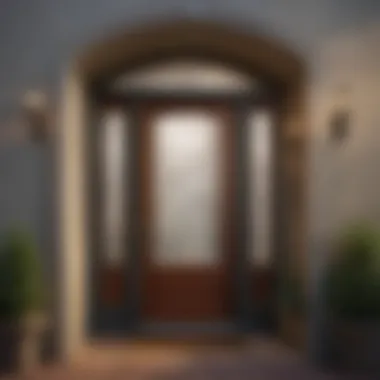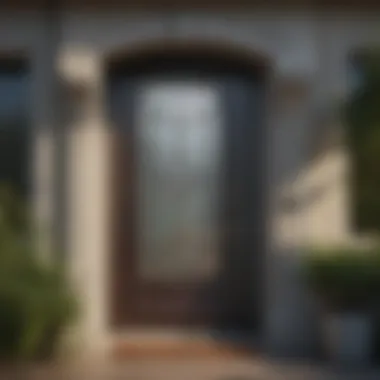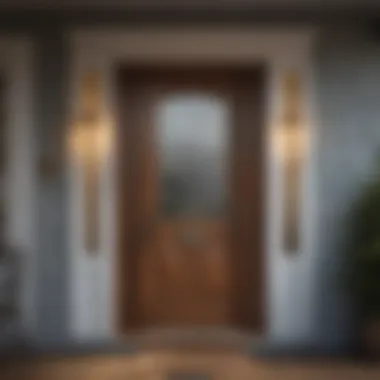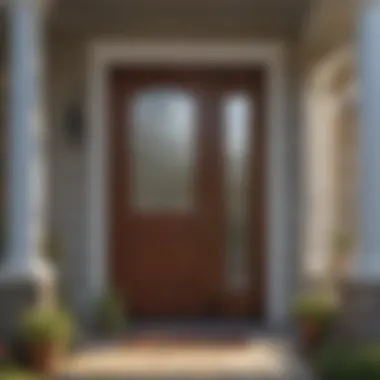The Ultimate Guide to Choosing the Best Storm Door


Intro
Storm doors are a practical item often overlooked in the realm of home improvement. They serve various purposes, such as protecting internal doors, providing an additional layer against weather elements, and enhancing energy efficiency. Understanding the distinct types of storm doors available, alongside their benefits, helps homeowners make informed decisions to reinforce their entryways.
One might wonder why choosing the correct storm door matters. The reason lies in how these doors impact the home’s thermal performance, security, and overall aesthetics. An effective storm door contributes to energy savings. It also aids in fortifying the home against intruders, while presenting a welcoming façade to guests. When planning a renovation or upgrade, these doors should not be an afterthought, but instead a key element of homeowners' designs.
Common Challenges and Solutions
Homeowners frequently encounter several common challenges regarding storm doors, causing frustration and uncertainty.
- Weather Resistance: Poor quality door may warp or bend under extreme weather, compromising effectiveness.
- Installation Difficulties: Not all homeowners are adept with DIY projects, making proper installation daunting.
- Aesthetic Mismatches: Finding a door that complements the home’s architectural style can be tricky.
The solutions vary:
- Choose Quality Products: Invest in reputable brands that provide durable and weather-resistant options. Brands like Larson and Anderson are known for reliable products.
- Seek Professional Help for Installation: If unsure, hiring a qualified installer can help alleviate worries around proper fitting and sealing.
- Customization Options: Many manufacturers now offer doors that can blend seamlessly with a variety of home designs. Choosing custom color finishes or decorative glass panels can enhance charm effectively.
Product Recommendations
Exploring options in storm doors is paramount for homeowners. A few products standout for their value and features:
- Anderson 3000 Series: This model offers a blend of security it designs to protect against the elements. It combines fiberglass construction with an external screen and solid glass inserts, allowing playful features.
- Larson Superstorm: Known for its sturdiness and superior insulation. This storm door series features a removable bottom sweep that efficiently keeps drafts away. Its design can accommodate entryway foot traffic well.
- Ply Gem Adjustable Storm Door: Offers fortified protection with aluminum framing and low-E glass, helping in energy savings. This storm door also provides design aesthetics without compromising sturdiness.
Step-by-Step Guides
To install a storm door correctly, homeowners should follow a structured approach:
- Measure the Doorway: Accurate measurements ensure a suitable fit. Account for width, height, and reveal if applicable.
- Choose the Right Door: Select based on material and features that address both practical and aesthetic needs.
- Gather Tools: Basic tools such as a drill, screwdriver, and level will make the process smoother.
- Remove Old Door (if applicable): Carefully take off existing door and its frame without damage if retaining is an option.
- Fit New Door: Work methodically through the instructions provided with the new door model for installation. Check levels and fit regularly.
- Seal Edges Properly: Ensure that all edges are sealed tightly using weather stripping for optimal insulation.
- Final Checks: Open and close the door multiple times to confirm functionality after installation.
Always consult specific product instructions, as different types could have unique installation needs.
Making selections and decisions around storm doors requires careful consideration. Following this guide helps narrow down choices, ultimately leading to a practical purchase that enhances every home, safeguarding both comfort and style.
Prelude to Storm Doors
The consideration of storm doors is vital for homeowners looking to enhance their homes. These installations provide an additional layer of protection against harsh weather while contributing to energy efficiency. At the same time, they allow for style and aesthetics in home entryways.
Definition and Purpose of Storm Doors
Storm doors are exterior doors typically installed in front of an existing door. Their primary purpose is to protect the entry door from the elements, such as rain, snow, and wind. They serve as a barrier against moisture and outdoor temperature fluctiuation, which can lead to conditions like drafts and higher energy bills. Additionally, they provide extra security, serving as a deterrent for potential intruders while allowing natural light and ventilation.
Historical Overview of Storm Doors
The concept of storm doors can be traced back centuries. Initially, they rose in popularity during the 19th century, as people sought effective methods to guard their homes from unpredictable weather. In specific geographic areas, storm doors became a standard in residential constructions due to their effective insulation properties.
Over the years, myriad advancements in design and materials have refined the storm door, leading to options today that range from fiberglass and metal to wooden constructions. Homeowners now benefit from contemporary technology that supports energy efficiency, thus making the selection of the right type of storm door more important than ever.
Types of Storm Doors


Understanding the various types of storm doors is crucial for homeowners looking to enhance their entryways. Each type offers unique features, benefits, and considerations which contribute significantly to home security, energy efficiency, and aesthetic value. The selection of storm doors can affect how well your home can endure harsh weather conditions while maintaining comfort indoors. Thus, it is vital to weigh the options carefully before making a decision that best suits your specific needs.
Fiberglass Storm Doors
Fiberglass storm doors present a strong combination of durability and insulation.
Advantages of Fiberglass Storm Doors
One of the primary advantages of fiberglass storm doors is their energy efficiency. They often have multi-chambered frames, which help in reducing heat loss during winter months. This characteristic plays an important role in minimizing energy costs for homeowners. Another prominent quality is their resistance to warping and corrosion, making them last long with proper care.
Fiberglass doors typically come in various styles and can mimic the appearance of wood. This helpful feature allows homeowners to enjoy an aesthetic that fits their home’s design without sacrificing functionality.
Disadvantages of Fiberglass Storm Doors
Despite their many benefits, fiberglass storm doors can have some disadvantages too. While the initial cost might be reasonable, repairs are often complex and potentially costly compared to other materials. Additionally, they might lack the strength of steel doors in extreme weather conditions where physical impact can be significant. Another important thing to consider is that colors may fade over time, requiring repainting or restoration to retain their initial appeal.
Metal Storm Doors
Metal storm doors, generally constructed from steel or aluminum, are renowned for their sturdiness.
Advantages of Metal Storm Doors
The durability of metal storm doors is their defining feature. Steel, in particular, offers high levels of security due to its resistance against break-ins and harsh weather. Moreover, they require very little maintenance. Most often, they come with a protective coating that prevents rust, making them an excellent choice for long-term use.
Their availability in various styles means homeowners can find metal storm doors that match their home’s aesthetic without compromising their security.
Disadvantages of Metal Storm Doors
But there are a few downsides to consider with metal storm doors. One main concern is heat conduction. Metal can get hot during sunny days, which may turn into an uncomfortable experience when used routinely. Furthermore, unless you take care in choosing color and styling, it can seem somewhat lackluster and industrial.
Wooden Storm Doors
Wooden storm doors provide warmth and elegance compared to their fiberglass and metal counterparts.
Advantages of Wooden Storm Doors
Wooden doors often have a unique charm that typical materials cannot replicate. Their capacity to be custom-made allows homeowners to match them exactly with their other home features. Also, wood provides natural insulation, which can improve overall energy efficiency. When properly treated, they may last a long while and usually only need basic upkeep such as staining and occasionally repainting.
Disadvantages of Wooden Storm Doors
On the other hand, wooden storm doors require regular maintenance to withstand elements like moisture and insects. They can¿ become warped or rotted if not treated right away. Their heavyweight also means the necessity of stronger hinges, which can add complexity during the installation.
Screen Storm Doors
Screen storm doors offer ventilation and provide an unobstructed view while keeping bugs outside. They are less about insulation and more about airflow. This feature is valuable in transitional seasons when airflow is desired without harsh external elements coming inside.
Hinged vs.
Sliding Storm Doors


Choosing between hinged and sliding storm doors involves thinking about your space layout. Hinged storm doors require swing room, meaning they need free area on either side. Conversely, sliding doors work well in tighter spaces, yet they tend to have more sealing issues. Both have set of advantages that shifts focus mostly on usability and space adaption.
Key Features to Consider
When selecting a storm door, certain features play a critical role in enhancing both function and beauty. Homeowners often seek to maximize benefits while ensuring a good match with their homes. This section explores essential attributes such as energy efficiency, security, design aesthetics, and durability. These factors not only improve the door's performance but also align with the owner’s preferences and needs.
Energy Efficiency and Insulation
An important aspect of storm doors is their energy efficiency. A well-equipped storm door acts as a barrier against outdoor temperatures. It minimizes heat loss during the winter and reduces heat gain in the summer. The right insulation can lead to a noticeable decrease in energy bills. When assessing energy efficiency, consider the door’s material, tightness of sealing, and the presence of thermal breaks. Choosing an energy efficient door contributes greatly to creating a comfortable home environment.
Security Features
Security cannot be overlooked when choosing a storm door. A robust storm door provides an added layer of protection against potential intruders. Look for options that come with reinforced locks and durable materials. Ideally, frames should be sturdy, and the door should fit tightly within its frame to avoid noticeable gaps. These features enhance overall safety. Assessing available security features helps in ensuring a more secure setting for your home.
Design and Aesthetics
Design and aesthetics should not be secondary elements. A storm door often serves as the first impression of a home. Therefore, careful considerations must include both its visual appeal and functionality. Let's break down key aspects within this category:
Color Options
Color options play a crucial role in complementing a home's exterior. A door color can harmonize with existing tones or create a standout feature. Common choices include classic whites, deep reds, or elegant blacks. Each color has its unique visual impact. For example, dark hues might impart a modern elegance, while whites provide a seamless, traditional look. Ultimately, choosing the right color not only enhances curb appeal but also reflects the homeowner's personality.
Style Compatibility
Style compatibility refers to how well a storm door aligns with the architectural features of a home. Selecting a door that fits the overall style fosters cohesion. Various materials, patterns, and design choices dictate what might align best. For instance, a wooden door may be ideal for a rustic home, while metal could suit a contemporary style. Ensuring alignment promotes aesthetic harmony. Thus, selecting a storm door with an eye for style compatibility is essential for maintaining, or enhancing, the beauty of your property.
Durability and Maintenance Needs
Durability is a critical factor of storm doors. Homeowners generally prefer materials with longer lifespans and minimal maintenance needs. Various materials yield different levels of resilience, such as fiberglass and metal. Additionally, ease of maintenance is valued by many; thus, choosing a door that stands up to elements without significant wear over time simplifies upkeep considerably. This characteristic supports not merely longevity but also sustained appeal.
Installation Process
The installation process of storm doors is a key factor that influences their overall effectiveness and benefits. A properly installed storm door can greatly enhance the entryway of a home. Installations can differ significantly in approach, depending on factors such as door type, frame conditions, and specific homeowner preferences. Therefore, understanding the nuances of installation can ensure durability, energy efficiency, and visual appeal. This section will discuss the critical elements involved in both DIY installations and professional service options.
DIY Installation Considerations
For many homeowners, a do-it-yourself installation of a storm door offers both cost savings and a sense of accomplishment. However, several factors should be considered before proceeding.
- Skill Level: Assess personal comfort with home improvement tasks. Basic tools like screwdrivers, levels, and drills may be needed. OSometime advanced handiwork may be required, such as aligning the frame.
- Tools Required: Common tools include a tape measure, drill, calibration level, and possibly a saw. It helps to have a step-ladder if required access beyond ground level is needed.
- Instructions and Documentation: Most storm doors come with detailed installation manuals. Following the provided instructions closely can prevent errors and accidents.
- Measuring Precisely: Accurate measurements ensure proper fit and functionality. Small discrepancies can cause less efficient door operations and energy leakage.
- Weather Considerations: Plan any installation around a period without severe weather. Wind or rain can complicate installations and also be hazardous.
Professional Installation Services
Choosing professional installers for storm doors presents another reliable option. Occupied homeowners might consider this route to save time and guarantee efficient work. Several reasons merit a professional touch:
- Expertise: Professionals possess experience in handling various doors and frames. This familiarity leads to quicker and more efficient installations.
- Proper Tools: Professionals have access to specialized tools and equipment that can improve installation quality.
- Warranty Protection: Many installation services come with warranties that protect the homeowner if issues arise post-installation. This reduces the long-term risk and liability for the homeowner.
- Complex Situations: If the frame show signs of damage or non-standard sizes, calling a specialist is advisable. Professionals can offer solutions ready and available that maybe Of personal efforts were missed.
- Guaranteed Quality: Professionals ensure that storm doors function as intended. Expertise limits risk of improper installations, ensuring that the door prevents air leaks and efficiently enhances energy savings.
Working with teams skilled in the area provides assurance and encourages desirable outcomes, ultimately contributing to homeowner satisfaction.
In summary, understanding the various elements of storm door installation can greatly contribute to achieving satisfactory results and long-term utility from one’s investment.


Maintenance of Storm Doors
Maintaining storm doors is crucial for prolonging their lifespans and ensuring that they serve their intended purpose effectively. Storm doors can enhance energy efficiency and provide security while also improving the aesthetics of your home. Regular maintenance prevents costly repairs in the future and extends the functional capabilities of the door. By treating these doors with care, homeowners can avoid inclement weather issues and additional energy expenses.
Cleaning and Care Recommendations
Routine cleaning of storm doors not only enhances their appearance but also helps maintain functionality. Dust, dirt, and pollen can accumulate over time, leading to more severe problems like corrosion in metal storm doors or rot in wooden ones. Here are some recommendations for keeping storm doors clean and in good shape:
- Use mild detergents: Mixing warm water with a gentle soap can remove the majority of dirt without harming the door's finishing.
- Soft cloth or sponge only: Avoid abrasive materials as they can scratch the surface.
- Rinse thoroughly: After cleaning, ensuring all soap is rinsed off prevents residue from solidifying on the door.
- Inspect hinges and seals: Check that hinges are free of debris. Seals should look intact without cracks.
- Regularly tighten screws: Ensure that all screws remain tight for optimal door functionality.
Performing these actions can help maintain the door’s sealing and efficiency, as well as prolong its lifespan.
Identifying and Addressing Common Issues
Even with regular upkeep, storm doors can encounter issues over time. Being proactive about identifying problems is an essential part of maintenance. Here are some common concerns that can arise:
- Drafts: If you feel cold air coming through, this indicates that weather stripping may need replacement. This small adjustment can significantly improve energy efficiency.
- Rust: Metal doors are particularly susceptible to rusting. If rust spots newer show up, they need addressing quickly. Scrubbing the area lightly and repainting can resolve the issue.
- Misalignment: Doors might swing or not close properly due to shifting. Inspect the hinges and frame to re-align as needed.
- Cracked or peeling finish: Wooden storm doors are generally affected by moisture. Should you notice the finish peeling, it may be time for refinishing.
Being aware of these issues allows for quick interventions, increasing the resilience of the door and maintaining your home’s aesthetics.
Regular maintenance and proactive checks can save homeowners on costly repairs and ensure the functionality of the storm door.
Warranty and Insurance Considerations
Understanding the warranty and insurance implications of installing a storm door can play a major role in safeguarding your investment. Homeowners should know how warranties can vary between different products, and what kind of coverage insurance policies offer.
Understanding Warranty Terms
Warranties can significantly affect the overall satisfaction and lasting value of any storm door purchase. Most manufacturers offer their own specific warranties, which typically cover structural defects and sometimes labor. In general, there are a few types of warranties to consider:
- Limited Warranty: This type covers defects for a certain period, usually around 5 to 10 years. It's often not comprehensive, so it might require added insurance for extensive coverage.
- Lifetime Warranty: A warranty that lasts for the life of the product. Not all lifetime warranties mean lifetime coverage under every circumstance, so it's wise to read the terms carefully.
- Labor Warranty: This includes the installation process and may add extra expense if it becomes necessary.
When reading the details, homeowners should look out for fine print mentioning premature tear or leaked entries. Before making a final purchase, it's beneficial to check if the warranty is transferrable, in case you decide to sell your home later on, which adds resale value.
"A well-structured warranty can enhance the lifetime of your storm door and add significant value to your home."
Insurance Repercussions When Installing a Storm Door
Adding a storm door may trigger insurance considerations that homeowners should not ignore. Understanding how your premium may change or if coverage will even extend to newly installed storm doors is critical. A few points involve:
- Verify Coverage: It is important to communicate with your homeowner’s insurance company. Some might not automatically cover installations like storm doors. You may need an addendum if your policy doesn't account for it.
- Possible Discount: Certain insurance companies might provide discounts, knowing that storm doors can add a layer of security. These provisions vary significantly among companies.
- Deductibles: Newly installed doors increase the home’s overall value. If any damage occurs, knowing your deductible becomes important because a higher home value might mean a higher upfront cost for damage.
- Liability: Installations often follow safety standards. Confirming these specifications fulfill local requirements can minimize liability issues.
Investing time in warranty details and insurance considerations can lead to a well-informed decision, empowering homeowners to safeguard their investment properly.
Culmination
In this article, we explored the integral aspects of storm doors, ranging from their functions to installation considerations. Understanding the significance of storm doors is crucial for any homeowner aiming to protect their home environment while enhancing its aesthetic appeal.
Storm doors serve various vital purposes. They provide an extra layer of insulation which helps in reducing energy costs. Improved security is another benefit, as storm doors offer additional protection against unauthorized entries. Moreover, storm doors can add to the visual coordination of your home, letting you choose styles that reflect personal taste.
Summary of Best Practices
To ensure optimal performance and longevity of storm doors, several practices are recommended:
- Regular Cleaning: Clear dirt and grime to avoid buildup that can cause damages over time.
- Inspect Weatherstripping: Look out for frayed or worn parts and replace as needed to preserve insulation.
- Check Hardware Components: Review hinges and locks periodically for any signs of wear. Dealing with fixable produced aesthetic degradation or loss of function.
- Seasonal Functional Testing: Ensure doors open and close smoothly throughout various times of the year to stay alert of any functional issues.
- Maintain Finish and Coating: Use protective paint or sealant on wooden doors to avoid rot and degradation.







